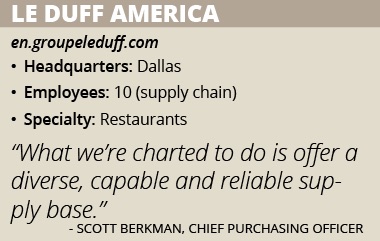Managing Supply Chain Synergies Across Multiple Brands: The Success Story of Le Duff America Inc.
Le Duff America benefits all through synergies in its supply chain as it manages several brands. By Alan Dorich
When a company has multiple brands, sourcing products can get rather complicated. Each brand has its distinctive culture, timelines and marketing efforts that set it apart from the rest, and meeting the needs of all is an exciting opportunity.
But Le Duff America Inc. successfully tackles that opportunity on a daily basis, Chief Purchasing Officer Scott Berkman says. “We have to be fluid with each brand’s needs,” he says. “The key aspect is to respect each brand’s objectives, culture, positioning and challenges period.”
The Dallas-based Le Duff America Inc. is the North American subsidiary of Groupe Le Duff, a restaurant group based in France. Le Duff America manages several brands, including Brioche Dorée, a lively urban café which offers its clients a fresh, thoughtful and seasonal menu of healthy salads, sandwiches and sweet indulgences.
It also manages la Madeleine Country French Café, a French fast casual restaurant serving 76 recipes from scratch daily, featuring soups, salads, sandwiches, entrées, pastries, viennoiserie and French specialties; Bruegger’s, which specializes in bagels, soups, salads and coffees; and Mimi’s Café, a full-service neighborhood café that offers easy access to French lifestyle in America, with signature items including roasted half chicken with hand-cut frites, mimosas and an indulgent breakfast offering. Berkman’s role as chief supply chain officer began in 2011 with the goal of implementing synergies across the supply base of multiple brands.

“The supply chain synergies were and are viewed as a key component of the power of Le Duff America,” Berkman says, noting he was asked to lead that initiative due to his industry experience, which included being part of Bruegger’s before Le Duff America acquired it in 2011. “Previously, [I] worked with multiple companies to synergize [them].”
During the five-year process, Le Duff America selected representatives for each brand who report directly to Berkman. “They have the same primary responsibility, which is to directly support the brands’ needs from a supply chain perspective,” he says.
“At the same time, we created category managers that would be responsible for common categories across the brands, based on people’s levels of expertise,” he says. These categories include protein, dairy products, packaging and beverages etc.
“They directly support a brand 80 to 90 percent of their time,” he says. “But as well, they’re going to be a manager for a specific category. They’re going to manage the RFP process for that category.”
One of Le Duff America’s supply chain successes was when it moved Bruegger’s, la Madeleine and Mimi’s all to the same cheese supplier. “We had three different providers of cheese,” Berkman recalls. When Le Duff America picked a single supplier, it made sure it was “distribution-friendly,” he says. “They have to be able to get into every one of our cafés via our network. It’s difficult when you have a supplier that is not able to get to every distributor.”
Le Duff America also picked a supplier that met the specs of each brand. “We didn’t get into the situation where we have the same slice weight per cheese or the same feather cut grade of shredded product,” Berkman adds.
“The spec is not forced upon the brand,” he says, noting that Le Duff America makes sure to have the brand’s approval. “We’re not going to make that commitment unless the brand endorses it.”
Positive Things
Today, more than 60 percent of Le Duff America’s suppliers service multiple brands in its portfolio. “This was a positive thing for our suppliers as well as to us,” Berkman says, noting that this led for significant cost savings for each entity. “It also enabled the supplier to have single points of contact, and greater volume opportunities which benefits all parties.
The company also has found a rhythm with its system so that contracts of similar products begin and end at the same time.
“Our operating premise is to be a strong support system and to allow our Le Duff America brands to serve their guests,” he says.
“We have the same template for every RFP, as well as the same protocols and the same principles,” he says. “What we’re charted to do is offer a diverse, capable and reliable supply base.”
Documented Value
Berkman is proud of Le Duff Americas and its supply chain group. “We are well respected within the brands,” he says. “We understand the value that we bring, [and] we document that value.”
The company documents these benefits with a scorecard. “Those benefits have enabled us to offset crises that have occurred,” Berkman says, noting that its supply chain group works together well, even across long distances.
“We have people in different parts of the country under me and we function well as one group,” he continues. “We’re able to bring significant value to each of the brands.”
Berkman sees expansion ahead for Le Duff Americas. “We have some brands that are in the growth mode, so they’re either increasing their franchising with opening up new units or expanding across the country,” he says. “We have brands that are partnering with other food concepts and doing co-brands.”